Soyuz TMA-11M / ISS Expedition 38
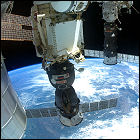 Soyuz TMA-11M is launched from Russia, on a fast-track trajectory to the International Space Station. The crew – Mikhail Tyurin, Rick Mastracchio and Koichi Wakata – arrives just six hours after liftoff. Each of the crew has been in space on at least three prior missions. Also aboard the Soyuz is the Olympic torch, on its own first visit to space; the torch, along with the Expedition 37 crew, returns to Earth in May 2014. Though Soyuz vehicles are usually handed off to the next returning crew, Soyuz TMA-11M returns to Earth with the same crew after a six-month stay. This mission marked the first time the International Space Station was crewed by nine people simultaneously since the end of the Space Shuttle era.
Soyuz TMA-11M is launched from Russia, on a fast-track trajectory to the International Space Station. The crew – Mikhail Tyurin, Rick Mastracchio and Koichi Wakata – arrives just six hours after liftoff. Each of the crew has been in space on at least three prior missions. Also aboard the Soyuz is the Olympic torch, on its own first visit to space; the torch, along with the Expedition 37 crew, returns to Earth in May 2014. Though Soyuz vehicles are usually handed off to the next returning crew, Soyuz TMA-11M returns to Earth with the same crew after a six-month stay. This mission marked the first time the International Space Station was crewed by nine people simultaneously since the end of the Space Shuttle era.

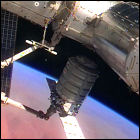 Having successfully demonstrated a working model of the Cygnus unmanned cargo spacecraft in 2013, Orbital Sciences delivers its first Cygnus vehicle under a new commercial resupply contract with NASA. The S.S. C. Gordon Fullerton (named for one of the earliest Shuttle astronauts, now deceased) cargo ship lifts off from Wallops Island, carrying nearly 2,800 pounds of supplies and equipment to the International Space Station. It will remain docked at the ISS for 36 days.
Having successfully demonstrated a working model of the Cygnus unmanned cargo spacecraft in 2013, Orbital Sciences delivers its first Cygnus vehicle under a new commercial resupply contract with NASA. The S.S. C. Gordon Fullerton (named for one of the earliest Shuttle astronauts, now deceased) cargo ship lifts off from Wallops Island, carrying nearly 2,800 pounds of supplies and equipment to the International Space Station. It will remain docked at the ISS for 36 days.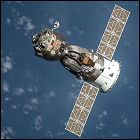 Part of the 39th full-time crew of the International Space Station lifts off from Russia’s Baikonur Cosmodrome aboard Soyuz TMA-12M. Aleksandr Skvortsov, Oleg Artemyev and Steven Swanson take up residence on the ISS for 169 days, becoming part of the Expedition 39 and 40 crews. This crew returns to Earth in September 2014 aboard the same vehicle.
Part of the 39th full-time crew of the International Space Station lifts off from Russia’s Baikonur Cosmodrome aboard Soyuz TMA-12M. Aleksandr Skvortsov, Oleg Artemyev and Steven Swanson take up residence on the ISS for 169 days, becoming part of the Expedition 39 and 40 crews. This crew returns to Earth in September 2014 aboard the same vehicle.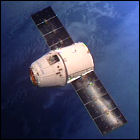 The third SpaceX Dragon unmanned resupply mission to the International Space Station lifts off, testing a new version of SpaceX’s Falcon 9 booster rocket which incorporates landing legs and an attitude control system designed to return the booster’s first stage safely to Earth for possible reuse. The attitude control system succeeds in cancelling out the booster’s roll and brings the first stage down for a controlled splashdown in the Atlantic Ocean. The Dragon capsule goes on to dock with the ISS two days later.
The third SpaceX Dragon unmanned resupply mission to the International Space Station lifts off, testing a new version of SpaceX’s Falcon 9 booster rocket which incorporates landing legs and an attitude control system designed to return the booster’s first stage safely to Earth for possible reuse. The attitude control system succeeds in cancelling out the booster’s roll and brings the first stage down for a controlled splashdown in the Atlantic Ocean. The Dragon capsule goes on to dock with the ISS two days later.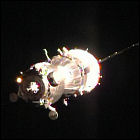 The 122nd Soyuz vehicle launched, Soyuz TMA-13M, lifts off from Russia to the International Space Station, carrying the station’s 40th crew to its stay in orbit. Aboard are flight engineers Maksim Surayev, Greg Wiseman and Alexander Gerst; of the three, only Surayev has previous spaceflight experience, and he will become the ISS Commander upon the departure of Expedition 39. Expedition 40’s stay aboard the ISS is slated to last six months, and Soyuz TMA-13M will be used as a return vehicle by the crew of Expedition 41 later in 2014. Though Soyuz TMA-13M was intended to use the recently developed six-hour fast-track launch trajectory to reach the station the same day it launched, technical glitches delayed its arrival at the ISS until May 28th.
The 122nd Soyuz vehicle launched, Soyuz TMA-13M, lifts off from Russia to the International Space Station, carrying the station’s 40th crew to its stay in orbit. Aboard are flight engineers Maksim Surayev, Greg Wiseman and Alexander Gerst; of the three, only Surayev has previous spaceflight experience, and he will become the ISS Commander upon the departure of Expedition 39. Expedition 40’s stay aboard the ISS is slated to last six months, and Soyuz TMA-13M will be used as a return vehicle by the crew of Expedition 41 later in 2014. Though Soyuz TMA-13M was intended to use the recently developed six-hour fast-track launch trajectory to reach the station the same day it launched, technical glitches delayed its arrival at the ISS until May 28th.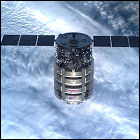 Orbital Sciences and NASA launch the second Cygnus unmanned cargo freighter to the International Space Station. Named after a recently deceased Shuttle astronaut, the S.S. Janice Voss carries over 3,000 pounds of new equipment and supplies to the station, where it remains docked for a month.
Orbital Sciences and NASA launch the second Cygnus unmanned cargo freighter to the International Space Station. Named after a recently deceased Shuttle astronaut, the S.S. Janice Voss carries over 3,000 pounds of new equipment and supplies to the station, where it remains docked for a month.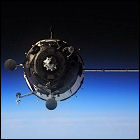 Part of the 40th full-time crew of the International Space Station lifts off from Russia’s Baikonur Cosmodrome aboard Soyuz TMA-14M. Upon arriving in orbit, one of the Soyuz solar panel “wings” fails to deploy, only unfolding properly once the vehicle has docked at the ISS. Aleksandr Samokutyayev, Yelena Serova and Barry Wilmore take up residence on the ISS, becoming part of the Expedition 40 and 41 crews. This crew returns to Earth in March 2015 aboard the same vehicle.
Part of the 40th full-time crew of the International Space Station lifts off from Russia’s Baikonur Cosmodrome aboard Soyuz TMA-14M. Upon arriving in orbit, one of the Soyuz solar panel “wings” fails to deploy, only unfolding properly once the vehicle has docked at the ISS. Aleksandr Samokutyayev, Yelena Serova and Barry Wilmore take up residence on the ISS, becoming part of the Expedition 40 and 41 crews. This crew returns to Earth in March 2015 aboard the same vehicle.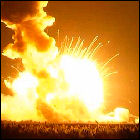 An unexpected malfunction destroys Orbital Sciences’ unmanned Cygnus cargo spacecraft a mere six seconds after its Antares booster rocket leaves the ground. Supplies and experiments bound for the
An unexpected malfunction destroys Orbital Sciences’ unmanned Cygnus cargo spacecraft a mere six seconds after its Antares booster rocket leaves the ground. Supplies and experiments bound for the 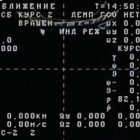 An unmanned Progress cargo vehicle, designated Progress M-27M, is launched by Russia to ferry 6,000 pounds of supplies, equipment and experiments to the International Space Station. But Progress ends up in the wrong orbit, tumbling out of control, with Russian ground controllers unable to send remote commands to the vehicle. Plans to dock the Progress capsule to the ISS are called off as further attempts are made to regain control; since the Progress is in the wrong orbit, it poses no present danger to the station.
An unmanned Progress cargo vehicle, designated Progress M-27M, is launched by Russia to ferry 6,000 pounds of supplies, equipment and experiments to the International Space Station. But Progress ends up in the wrong orbit, tumbling out of control, with Russian ground controllers unable to send remote commands to the vehicle. Plans to dock the Progress capsule to the ISS are called off as further attempts are made to regain control; since the Progress is in the wrong orbit, it poses no present danger to the station.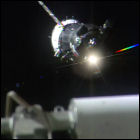 Russia launches three international crew members to the International Space Station aboard Soyuz TMA-17M. Upon reaching orbit, cosmonaut Oleg Kononenko and astronauts Kjell Lindgren and Kimiya Yui discover their spacecraft has a familiar problem: one of the Soyuz solar panel “wings” has failed to extend. As the vehicle is on a five-and-a-half-hour fast-track trajectory to the station, the mission continues and the Soyuz docks at the ISS without incident. After docking, the stuck solar panels extend fully, as happened in 2014’s Soyuz TMA-14M mission. The new visitors to the station will spend four months as part of the Expedition 44 crew.
Russia launches three international crew members to the International Space Station aboard Soyuz TMA-17M. Upon reaching orbit, cosmonaut Oleg Kononenko and astronauts Kjell Lindgren and Kimiya Yui discover their spacecraft has a familiar problem: one of the Soyuz solar panel “wings” has failed to extend. As the vehicle is on a five-and-a-half-hour fast-track trajectory to the station, the mission continues and the Soyuz docks at the ISS without incident. After docking, the stuck solar panels extend fully, as happened in 2014’s Soyuz TMA-14M mission. The new visitors to the station will spend four months as part of the Expedition 44 crew. Warner Music Canada releases the album
Warner Music Canada releases the album 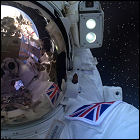 A relatively routine spacewalk at the International Space Station is cut short when astronaut Tim Kopra notices a globule of water in the helmet of his spacesuit. Perhaps mindful of
A relatively routine spacewalk at the International Space Station is cut short when astronaut Tim Kopra notices a globule of water in the helmet of his spacesuit. Perhaps mindful of 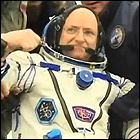 Having traveled to the International Space Station as part of the Expedition 43 crew, astronaut Scott Kelly and cosmonaut Mikhail Korniyenko return to Earth after their heavily-publicized “One-Year Mission”, along with cosmonaut Sergey Volkov. Though the duration of the “One-Year Mission” is closer to 11 months, Kelly has broken the American record for continuous time spent in space. NASA hopes medical data gathered during his stay will help to keep future astronauts healthy, both physically and mentally, on long-term flights to such future destinations as Mars.
Having traveled to the International Space Station as part of the Expedition 43 crew, astronaut Scott Kelly and cosmonaut Mikhail Korniyenko return to Earth after their heavily-publicized “One-Year Mission”, along with cosmonaut Sergey Volkov. Though the duration of the “One-Year Mission” is closer to 11 months, Kelly has broken the American record for continuous time spent in space. NASA hopes medical data gathered during his stay will help to keep future astronauts healthy, both physically and mentally, on long-term flights to such future destinations as Mars. SpaceX launches the unmanned Dragon CRS-8 (Commercial Resupply Mission 8) to the International Space Station, carrying supplies and experiments, as well as delivering via its cargo trunk the Bigelow Expandable Activity Module (BEAM), the first new addition to the ISS since 2011. The flight is a success, and for the first time, the Falcon 9 first stage returns intact to an unmanned drone barge in the Atlantic Ocean, where it can be refurbished and reused. Though SpaceX has previously brought an intact booster down on dry land, this is the first success in several attempts to recover the spent first stage at sea.
SpaceX launches the unmanned Dragon CRS-8 (Commercial Resupply Mission 8) to the International Space Station, carrying supplies and experiments, as well as delivering via its cargo trunk the Bigelow Expandable Activity Module (BEAM), the first new addition to the ISS since 2011. The flight is a success, and for the first time, the Falcon 9 first stage returns intact to an unmanned drone barge in the Atlantic Ocean, where it can be refurbished and reused. Though SpaceX has previously brought an intact booster down on dry land, this is the first success in several attempts to recover the spent first stage at sea.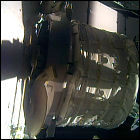 For the first time since the final
For the first time since the final 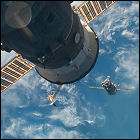 The second uprated Soyuz MS vehicle is launched from Baikonur Cosmodrome. The crew of Soyuz MS-02 are International Space Station Expedition 49 crew members Sergey Ryzhikov, Andrei Borisenko, and Shane Kimbrough; these three will become the Expedition 50 crew in November, and will return to Earth in February 2017 aboard the same vehicle.
The second uprated Soyuz MS vehicle is launched from Baikonur Cosmodrome. The crew of Soyuz MS-02 are International Space Station Expedition 49 crew members Sergey Ryzhikov, Andrei Borisenko, and Shane Kimbrough; these three will become the Expedition 50 crew in November, and will return to Earth in February 2017 aboard the same vehicle.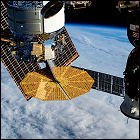 The
The 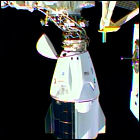 Following the first crewed test flight earlier in the year, SpaceX launches the first operational Crew Dragon flight to the International Space Station, with astronauts Michael S. Hopkins, Victor J. Glover, Sôichi Noguchi, and Shannon Walker aboard. This is also the first long-duration mission for the Crew Dragon, which will see the spacecraft remain docked to the station for several months before returning to Earth.
Following the first crewed test flight earlier in the year, SpaceX launches the first operational Crew Dragon flight to the International Space Station, with astronauts Michael S. Hopkins, Victor J. Glover, Sôichi Noguchi, and Shannon Walker aboard. This is also the first long-duration mission for the Crew Dragon, which will see the spacecraft remain docked to the station for several months before returning to Earth.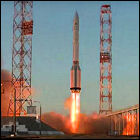 Russia launches the Nauka Multipurpose Logistics Module Upgrade component of the International Space Station. Part of the original design for the ISS, Nauka was built in time to be launched in 2007, but its addition to the station was repeatedly delayed, missing planned launch windows in 2009, 2013, 2015, 2017, 2019, and 2020. Parts of Nakua required upgrades and replacements over the years that it awaited launch, as these parts began to fail certification due to their age. (Much of the module was 14 years old before it ever made it to the launch pad.) Nakua, designed to automatically rendezvous and dock with the station, begins encountering technical problems once it is in orbit, delaying the docking maneuver. It replaces the Russian Pirs module, which becomes the first ISS module to be detached and allowed to re-enter Earth’s atmosphere.
Russia launches the Nauka Multipurpose Logistics Module Upgrade component of the International Space Station. Part of the original design for the ISS, Nauka was built in time to be launched in 2007, but its addition to the station was repeatedly delayed, missing planned launch windows in 2009, 2013, 2015, 2017, 2019, and 2020. Parts of Nakua required upgrades and replacements over the years that it awaited launch, as these parts began to fail certification due to their age. (Much of the module was 14 years old before it ever made it to the launch pad.) Nakua, designed to automatically rendezvous and dock with the station, begins encountering technical problems once it is in orbit, delaying the docking maneuver. It replaces the Russian Pirs module, which becomes the first ISS module to be detached and allowed to re-enter Earth’s atmosphere.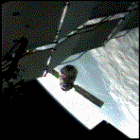 Delayed several days due to technical glitches that occurred after its launch, the Russian Nauka Multipurpose Logisitics Module Upgrade docks with the International Space Station. Some glitches continue to occur during the modules approach and docking phase, with the Russian crew members aboard the station manually intervening when necessary. After docking, however, Nauka’s thrusters begin firing, rotating the station 45 degrees off-axis, eventually exhausting its fuel supply. Once its thrusters are no longer capable of moving the station, the station is restored to its original orientation, with NASA reassuring the public that the event posed no danger to the crew. Some spacewalks will be required to fully connect Nauka’s systems to those of the rest of the station, but it is expected to become the hub of Russia’s research activity aboard the ISS.
Delayed several days due to technical glitches that occurred after its launch, the Russian Nauka Multipurpose Logisitics Module Upgrade docks with the International Space Station. Some glitches continue to occur during the modules approach and docking phase, with the Russian crew members aboard the station manually intervening when necessary. After docking, however, Nauka’s thrusters begin firing, rotating the station 45 degrees off-axis, eventually exhausting its fuel supply. Once its thrusters are no longer capable of moving the station, the station is restored to its original orientation, with NASA reassuring the public that the event posed no danger to the crew. Some spacewalks will be required to fully connect Nauka’s systems to those of the rest of the station, but it is expected to become the hub of Russia’s research activity aboard the ISS.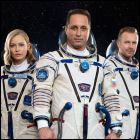 Soyuz MS-19 is launched to the International Space Station from Baikonur Cosmodrome, carrying a three-person crew (the first all-Russian Soyuz crew since Soyuz TM-30 in 2000) to a brief stay aboard the International Space Station. Cosmonaut Anton Shkaplerov, a veteran of three previous flights, commands and pilots the mission, whose other crewmembers, film director Klim Shipenko and actress Yulia Peresild, are passengers visiting the station to shoot approximately 40 minutes of footage for a movie to be released at a later date. The revival of “space tourism” aboard the ISS sparks new controversy about the topic, particularly within the Russian space program, mirroring similar controversy surrounding the burgeoning suborbital passenger spaceflight industry. Shipenko and Peresild return to Earth after 12 days aboard the ISS, catching a ride home aboard Soyuz MS-18 alongside returning ISS Commander Oleg Novitskiy; Shkaplerov remains aboard the ISS to assume command. Soyuz MS-19 will return the current ISS crew to Earth in March 2022.
Soyuz MS-19 is launched to the International Space Station from Baikonur Cosmodrome, carrying a three-person crew (the first all-Russian Soyuz crew since Soyuz TM-30 in 2000) to a brief stay aboard the International Space Station. Cosmonaut Anton Shkaplerov, a veteran of three previous flights, commands and pilots the mission, whose other crewmembers, film director Klim Shipenko and actress Yulia Peresild, are passengers visiting the station to shoot approximately 40 minutes of footage for a movie to be released at a later date. The revival of “space tourism” aboard the ISS sparks new controversy about the topic, particularly within the Russian space program, mirroring similar controversy surrounding the burgeoning suborbital passenger spaceflight industry. Shipenko and Peresild return to Earth after 12 days aboard the ISS, catching a ride home aboard Soyuz MS-18 alongside returning ISS Commander Oleg Novitskiy; Shkaplerov remains aboard the ISS to assume command. Soyuz MS-19 will return the current ISS crew to Earth in March 2022.